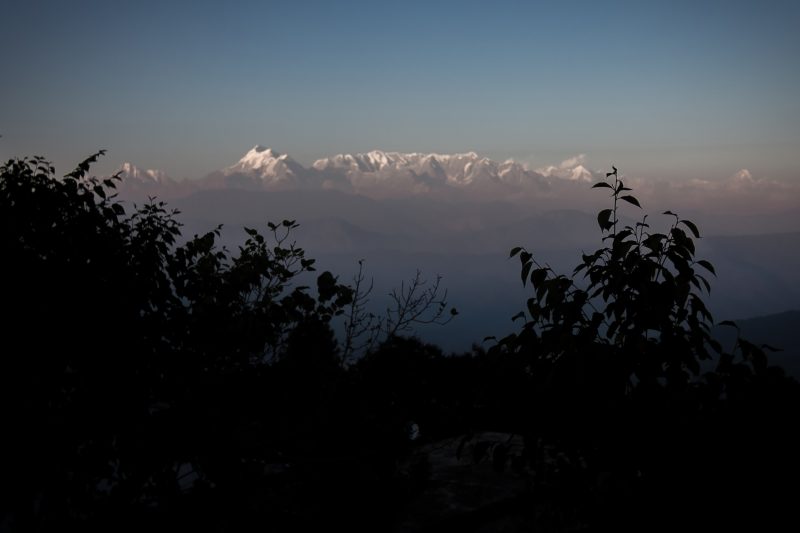Bodies spotted in search for missing Nanda Devi climbers in India
Hundreds of climbers from across the world visit India to scale mountains across the Himalayan chain (view of Indian Himalayas from Kausani hill station) (Agnes BUN)
Pithoragarh (India) (AFP) – A helicopter searching for eight climbers including seven foreigners missing on India’s second-highest peak spotted bodies on Monday, a military source said.
“Some bodies were visible during the helicopter recce. They were on the same route as the climbers had taken,” the source said, requesting anonymity.
“The chances of survival are very, very bleak at a height of 15-18,000 feet (4,570-5,500 metres) in such a cold climate. It is almost impossible they are alive,” the source added.
A second source put the number of bodies spotted at five.
A police source told AFP that rescuers would try to reach the point where the bodies had been spotted to retrieve them.
A media briefing was expected later Monday.
Nothing has been heard from the four Britons, two Americans, one Indian and one Australian on the 7,826-metre (25,643-foot) Nanda Devi in the Himalayas since May 26.
After they were reported missing on Friday, a major search operation including two helicopters, drones and dozens of mountain rescuers has been in full swing, hampered however by poor weather and the remoteness of the area.
Authorities were able to reduce the search area to roughly 50 square kilometres (20 square miles) following information from four British climbers rescued Sunday from Nanda Devi base camp.
They had been in contact with the larger group until May 26 when heavy snowfall and avalanches struck.
A separate rescue team had reached the base camp but were yet to embark on the 90-kilometre (55-mile) trek upwards to the area where the eight be.
Vivek Kumar Pandey, a spokesman for the Indo-Tibetan Border Police, said that taking rescuers there by helicopter was not practicable either.
“Even if we airdrop someone, he will need at least six to eight days to acclimatise before he can undertake any rescue mission,” Pandey told AFP.
The missing climbers, led by Briton Martin Moran — who has two previous successful ascents of the mountain — had initially set out on May 13 for the eastern peak of Nanda Devi.
But in a post on May 22 on the Facebook page of the mountaineering company he runs, Moran Mountain, said they were set to attempt “an unclimbed peak” at 6,477 metres.
They were expected to report back to base camp on May 26 but a porter stationed there reported to authorities that the group remained missing on May 31, prompting the search operation.
“They are all good climbers, they are not amateurs. But our aerial recces are showing certain pockets triggered by large avalanches,” Pandey said.
– ‘No sign’ –
A statement by the Moran family on Sunday said they have been informed by the Indian Mountaineering Federation that the air search has “revealed the scale of the avalanche, but no sign of the climbers, their equipment nor their tents.”
The Sydney Morning Herald named the Australian member as British-born Ruth McCance.
It quoted her husband Trent Goldsack as saying that her last communication to him had been a text message around a week ago saying: “OK at base camp.”
Another of the British climbers was reported to be Richard Payne, a lecturer at the University of York.
“We remain extremely concerned for his safety and our thoughts are with his family, friends and colleagues at this difficult time,” a spokesman for the British university said.
Hundreds of climbers from across the world visit India to scale mountains across the Himalayan chain, and the peaks of Nanda Devi are considered the toughest to scale.
The first successful ascent of the Nanda Devi summit was in 1936.
India has 10 peaks above 7,000 metres, including Kangchenjunga — the world’s third highest — sandwiched between India and Nepal.
Four Indians were among 11 climbers that died climbing Mount Everest in the latest season that ended last week amid allegations of overcrowding on the world’s highest peak.
Mountaineering experts criticised the government of Nepal for giving permits to anyone ready to pay $11,000, letting rookie climbers risk their lives and those of others on the slopes.
Disclaimer: Validity of the above story is for 7 Days from original date of publishing. Source: AFP.


